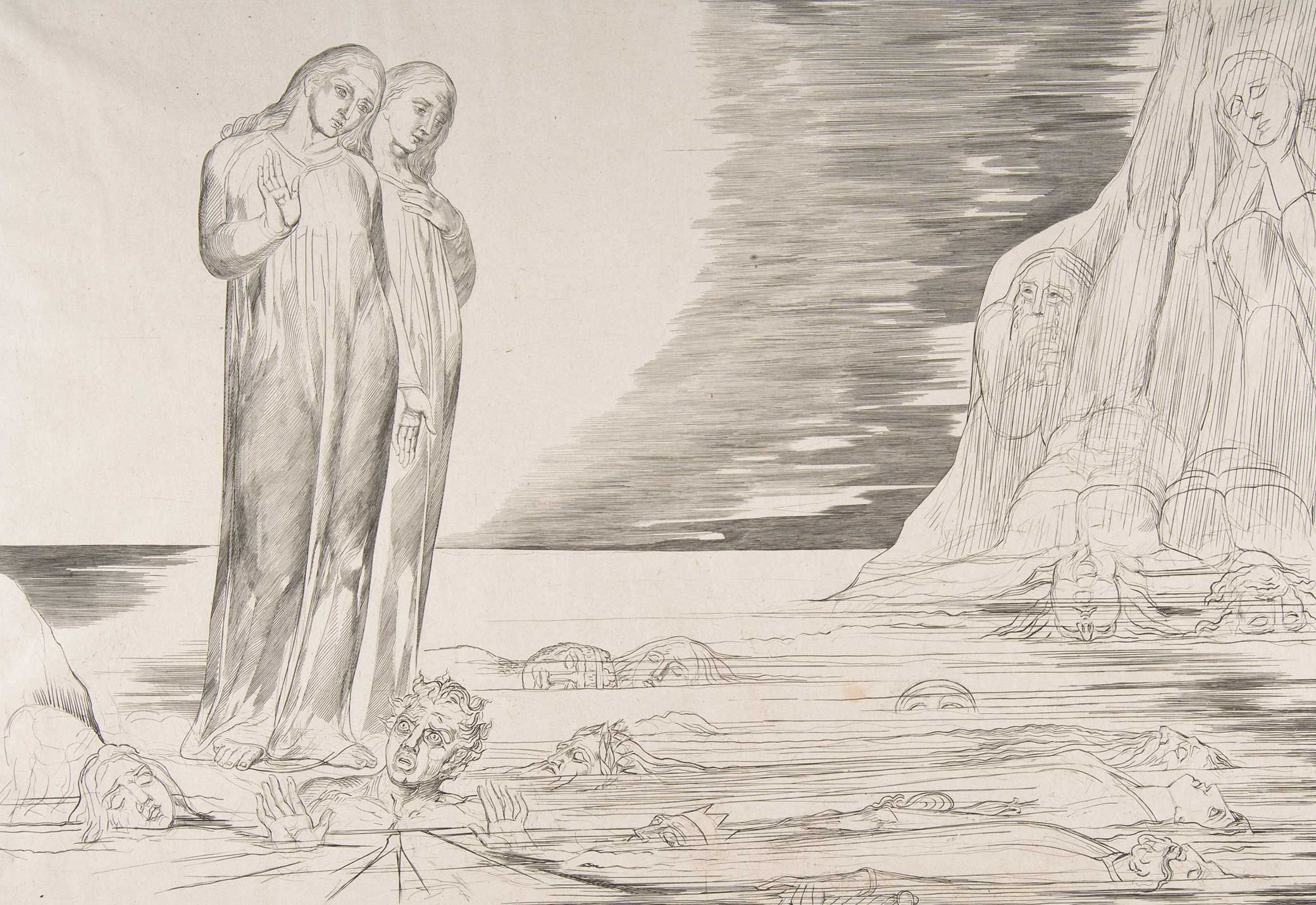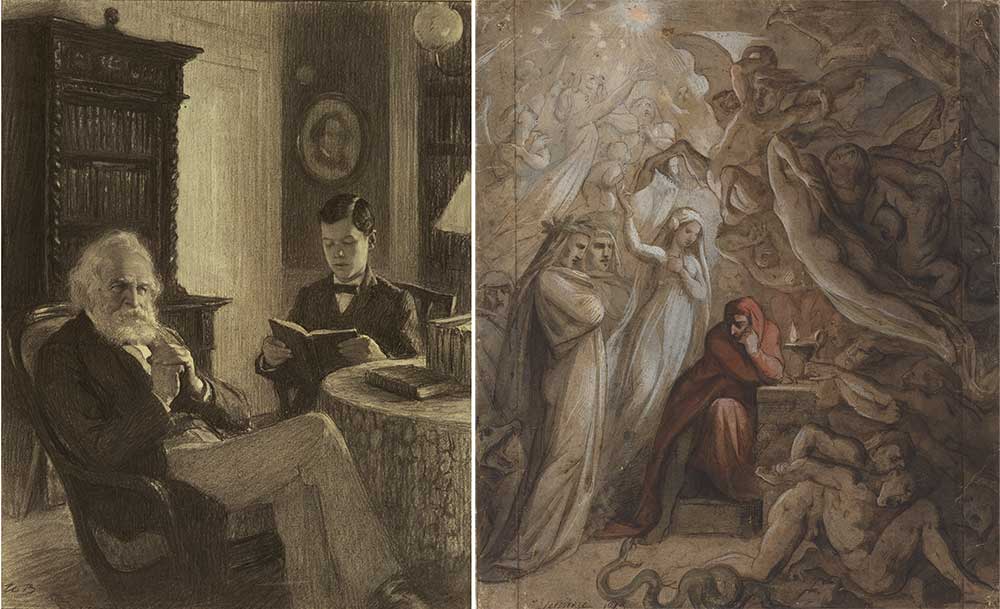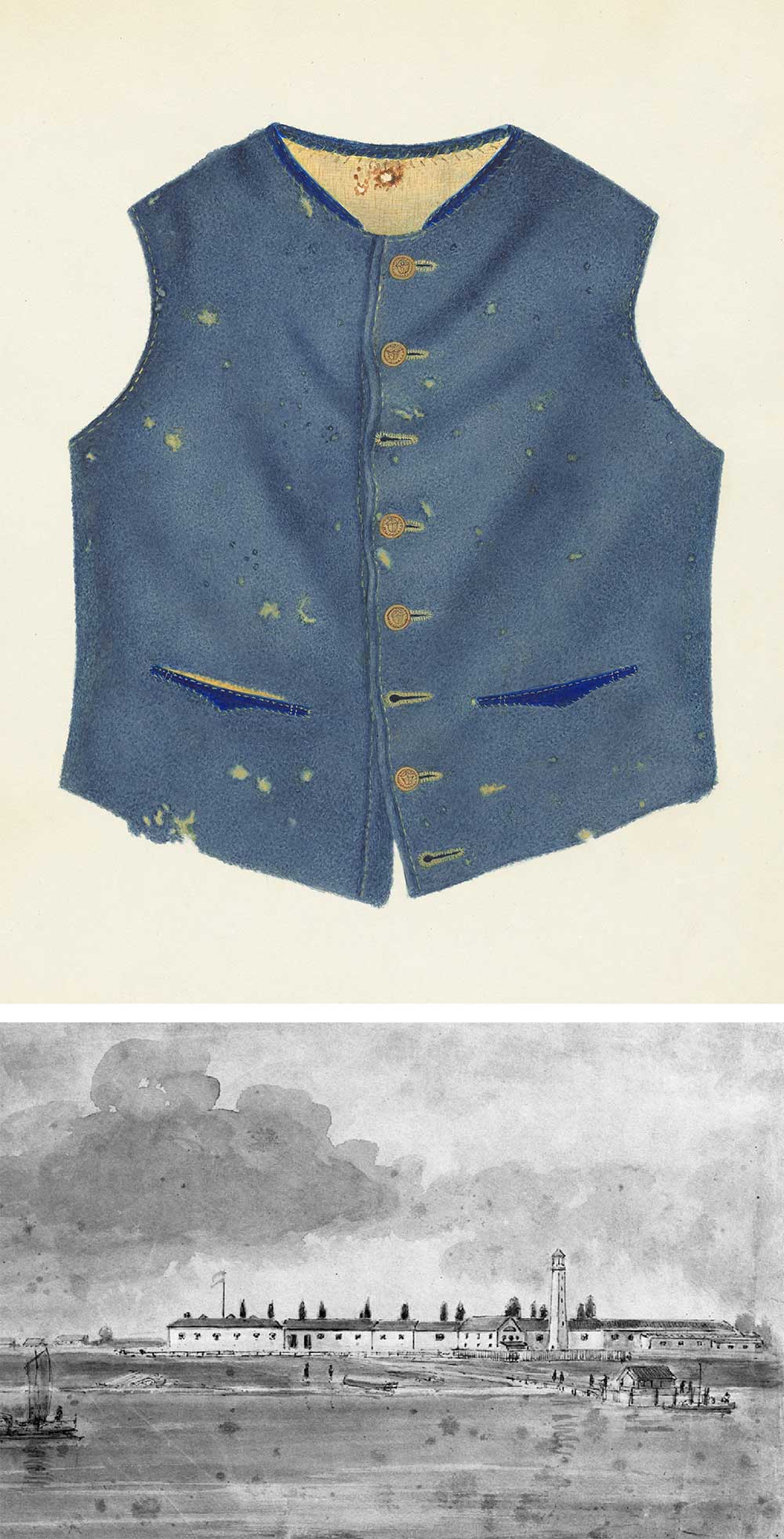
The Circle of Traitors: Dante’s Foot Striking Bocca degli Abbate, by William Blake, c. 1825. The Metropolitan Museum of Art, Rogers Fund, 1917.
In the summer of 1865 Jefferson Davis sat imprisoned in a room at Fort Monroe, situated on a skinny peninsula in Virginia between the Chesapeake and perdition. The so-called president of the Confederate States of America would spend two years there before his trial for treason. A missive by Major General Nelson A. Miles dated July 20, 1865, records that the prisoner appeared “extremely dejected. He takes little or no exercise, constantly sitting in his chair or reclining on his couch.” There in the unheated white-bricked room with an arched ceiling, a single bed, and a wooden desk on which he was allowed to record his version of events, Davis was unbowed in his rebellion, and remained so for the rest of his life. “Nothing fills me with deeper sadness,” he wrote two decades after his 1867 pardon by President Andrew Johnson, “than to see a Southern man apologizing for the defense we made of our inheritance.”
The same year Davis was released, Henry Wadsworth Longfellow published the first U.S. translation of Dante’s The Divine Comedy. Writing in his yellow-wood-paneled manse in red-bricked Cambridge, the Unionist may have seen in Davis the disloyalty exhibited by that arch-heretic Satan, condemned to the lowest circle of Hell. Like the self-pitying former president, he narcissistically bemoans his fate, having discovered that “weeping itself there does not let them weep, / And grief that finds a barrier in the eyes / Turns itself inward to increase the anguish.” Anyone reading Longfellow’s translation in 1867 who shared his politics would have found contemporary resonance in the old poem, even if the echoes were entirely implicit.
Longfellow is often seen as a writer once fit for children and now nobody. His reputational defenestration after dying in 1882 seems an equal and opposite reaction to the popularity he enjoyed while alive; critic Michael Schmidt wrote in 1998 that in the nineteenth century “American poetry was Longfellow.” He was born in Portland, Maine, in 1807—when it was still part of Massachusetts—and educated at Bowdoin College, where he taught and gained fluency in Italian, French, Spanish, Portuguese, and German before migrating to Harvard. Longfellow was the most widely read and feted American poet in the world, so popular that he was able to retire from Harvard in 1854 after eighteen years of teaching modern languages and focus on his writing, with epics like The Song of Hiawatha and Evangeline: A Tale of Acadie going through multiple printings.
Artistic popularity can be fleeting, however, and easily forgotten or even mocked when new trends supplant past conventions. Walt Whitman dismissed Longfellow after the latter’s passing as a “poet of melody, courtesy, deference,” a figure who is “not revolutionary, brings nothing offensive or new, does not deal hard blows.” Later generations familiar with only Longfellow’s most ubiquitous works followed the poet’s lead, dismissing the best-selling writer as a fireside versifier of anodyne lyrics and patriotic pablum.
This disparagement is not just unfair but a little cruel. Longfellow’s verse may have been formal, but his politics were radical—and decent. A committed abolitionist, he penned the collection Poems on Slavery in 1842 and donated his royalties to freeing enslaved people. Longfellow wasn’t as vocal in his commitments as his close friend Charles Sumner—the Massachusetts senator who was almost caned to death on the U.S. Senate floor by South Carolina representative Preston Brooks after giving a speech on the “slave oligarchy”—but he was no less passionate. Historian William H. Goetzmann writes in Beyond the Revolution: A History of American Thought from Paine to Pragmatism that “popularity disguised his subtlety,” leaving critics to decree that Longfellow’s work possessed “no metaphysics, no hidden symbols to unearth.” Historian Jill Lepore convincingly argued in 2010 that even Longfellow’s most cloying verse, “Paul Revere’s Ride,” is anything but timid. Inspired by the 1859 martyrdom of the radical abolitionist John Brown—whose execution marked the “date of a new revolution quite as much needed as the old one,” Longfellow wrote in his diary—the poem was published in The Atlantic Monthly in December 1860, the same month that South Carolina seceded. Lepore explains that the poem was universally “read as a rallying cry for the Union.” Longfellow’s exhortation that in the “hour of darkness and peril and need, / The people will waken and listen to hear” refers not to approaching Red Coats but to Confederates. The symbolism would have been obvious to contemporaneous readers.
Longfellow’s less immediately accessible hobby—translating The Divine Comedy—reinforces the argument that his period pieces were potent reflections of the moment in which they were produced, rather than instantaneously saccharine archaisms. Before Longfellow, no American had ever translated all of Dante’s fourteenth-century Italian epic about the author’s descent through the fires of Inferno, his journeys through Purgatory, and his ultimate ascension to Paradise. In the nineteenth-century United States, riven with anti-Catholicism, there was an audacity to the attempt. Yet Dante wasn’t without his enthusiasts. Both sides of the Atlantic saw a vogue for the Florentine that resulted in “one of the few truly successful English translations,” according to the Dante scholar Joseph Luzzi, who wrote in a 2016 essay that Longfellow’s effort remained “in many respects still the best.” In 1863 he twice-widowed poet started translating one canto of the “Inferno” every day while his son Charley served in the Army of the Potomac. Longfellow writes in his 1842 lyric “Mezzo Cammin” (borrowing its title from Dante), “Half of my life is gone, and I have let / The years slip from me and have not fulfilled / The aspiration of my youth.” Three decades later, he translated Dante’s first lines as “Midway upon the journey of our life / I found myself within a forest dark.”

Dante’s conception of hell famously places the most perfidious sinners deeper into the earth’s bowels. Hell is organized in nine concentric circles, from the antechamber of Limbo down through the remainder, where those guilty of lust, gluttony, greed, wrath, heresy, violence, fraud, and finally treason are punished. Nothing merits judgment more than disloyalty. While traveling among this procession of sinners, Dante encounters Fra Alberigo, a countryman who had been involved in Florence’s civil strife. Contrary to our expectations, the deepest point in Dante’s hell is frigidly cold (Jefferson Davis’ cell was significantly warmer). Alberigo asks if Dante will clear the icicles from his frozen eyes so that he may weep. Dante refuses, for “to be rude to him was courtesy” in Longfellow’s translation. This is the regard in which rebels should be held, punished in a null space as far from heaven as possible.
Alberigo is only one of many fellow Florentines who find themselves here. Dante—living in exile during most of his writing career—felt free to imagine the punishments of those who had betrayed the Republic. As Longfellow’s nation was ripped apart by Civil War, so was Dante’s Florence, jostled over by various factions, primarily the Guelfs, who were supported by the pope, and the Ghibellines, who were allied with the Holy Roman Emperor. Dante belonged to a faction of the former, and upon their defeat he was punished with expulsion from the city. Accused of treason himself, he saw the disunity of Florence as an affront to republican (and divine) harmony.
Other eternally frozen inmates in this circle include King Arthur’s traitorous nephew Mordred; Antenor of Troy, who collaborated with the Greeks; Charlemagne’s disloyal rear guard Ganelon; and the first murderer, Cain. Dante’s Satan is a massive three-headed creature weeping icicles and forever gnawing on the bodies of history’s most notorious traitors: Cassius, Brutus, and Judas Iscariot. Puritan New England had long been in the thrall of the seventeenth-century British poet John Milton’s Paradise Lost, with a romantic portrayal of Lucifer’s rebellion that led William Blake to declare that the author was “of the Devil’s party without knowing it.” For a steadfast Unionist, however, the Confederate rebellion had no romance. Dante’s portrait of the grotesque Satan trapped in ice was more fitting.
For Dante, treason—whether betrayal of kindred, country, or God—was the sin most deserving of punishment because it severed the connections that made the maintenance of a commonwealth possible. Implicit within this framework is the idea of covenant, that the loyal upholding of a creed must be established among a community and with their God. New England intellectuals like Longfellow saw covenant at the core of American identity, a creed expressed in Thomas Jefferson’s declaration that “all men are created equal.” Like most Northerners, Longfellow understood the insurrection that began at Fort Sumter as a betrayal of the nation, but more importantly it was treason against the noble creed of the United States itself, something admitted by the Confederate vice president Alexander H. Stephens—who in an infamous 1861 address declared that “our new government is founded upon exactly the opposite ideas” of the Declaration of Independence, for “its cornerstone rests upon the great truth that the negro is not equal to the white man; that slavery, subordination to the superior race, is his natural and normal condition.”

Writing in his diary that same year, Longfellow observed that “the dissolution of the Union goes slowly on…Behind it all I hear the low murmur of the slaves, like the chorus in a Greek tragedy.” He finished his translation the year of Robert E. Lee’s surrender at Appomattox, noting in his diary, “So ends the rebellion of the slaveowners.” Dante’s cantos about the punishments treason deserves couldn’t have helped but have resonance. Not exactly a king in the traditional sense, Dante’s Satan is punished for his original rebellion alongside history’s most notorious traitors.
Here is Longfellow’s version of Dante’s Satan:
With six eyes did he weep, and down three chins
Trickled the tear-drops and the bloody drivel.
At every mouth he with his teeth was crunching
A sinner, in the manner of a brake
So that he three of them tormented thus.
Here is depicted exactly what treason deserved. Antebellum Jefferson Davis was an aristocratic man, but just as Lucifer had once been beautiful before his fall, so now “were he was fair once, as he now is foul, / And lifted up his brow against his Maker, / Well may proceed from him all tribulation.”
Virtually all of the architects of the Confederacy remained unpunished. Even more of a betrayal, the radical promise of Reconstruction would also be abandoned in 1877, only five years before Longfellow’s death. Not only did the Confederate traitors largely avoid justice while alive but the satanic bargains of Reconstruction’s demise, whereby the federal government saw fit to unify North and South on the basis of institutional white supremacy, falsely exonerated men like Davis and Lee. In the following decades these men would be honored with statues erected in Southern (and beyond) squares and on battlefields, with reliefs on the sides of mountains and the names of highways. The Civil War demonstrated that America’s original covenant could be nothing of the sort as long as people were enslaved, and though postwar amendments to the Constitution partially rectified this injustice, Longfellow’s hoped-for “new birth of freedom,” as President Abraham Lincoln called it, was only partial.
Nonetheless, Longfellow still believed that Dante had something to tell us as a prophet of republican freedom, describing him in an 1867 sonnet as the “star of morning and liberty.” Longfellow might have had something to tell us about republican freedom himself. With Dante he acquired a vocabulary of grief and alienation, a language of redemptive love, and a mystical appreciation of divinity. He also crafted an idiom of justice against those guilty of betrayal. Though Whitman sometimes had harsh words about the poet, he would still speak of Longfellow much as the latter did of Dante, as a “counteractant” to “an age tyrannically regulated.”
In 1865, basking in the Union victory and the still-undashed promise of an actual new birth of freedom, Longfellow accepted an invitation to recognize the six hundredth birthday of Dante, traveling to Florence at the behest of the radicals then in the process of Risorgimento, unifying Italy into a modern nation. Italian partisans, such as the revolutionary Giuseppe Garibaldi, had followed and cheered the Union victories, and at the anniversary banquet in the presence of Longfellow, a dignitary toasted “Stati Riuniti”—the “Re-United States” of America. Having come through the apocalypse of Civil War, there was hope even while the purgatorial work of redemption remained. As Longfellow’s Dante sighed upon leaving hell, “Thence we came forth to rebehold the stars.”